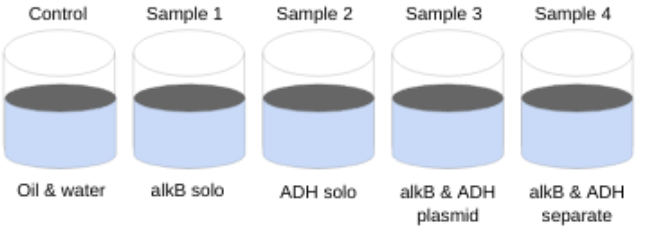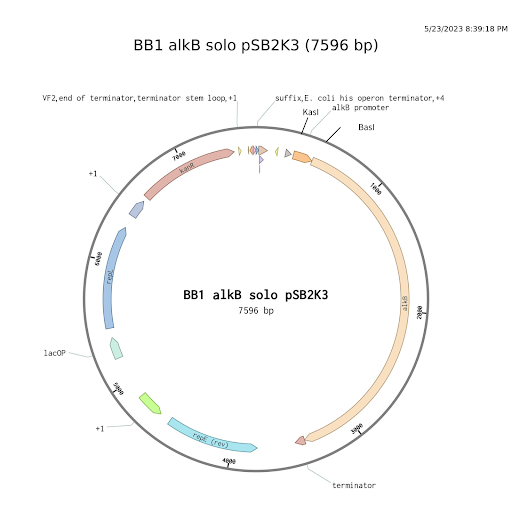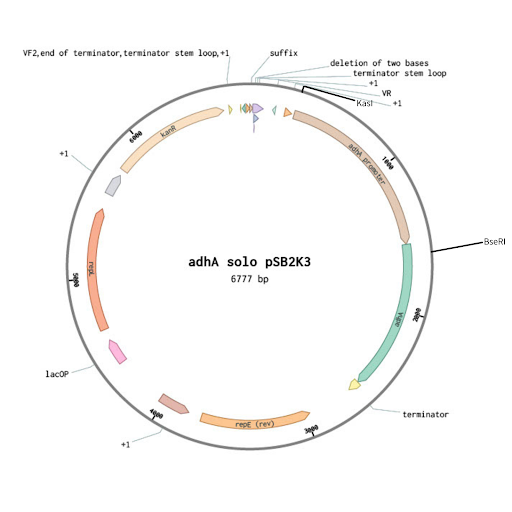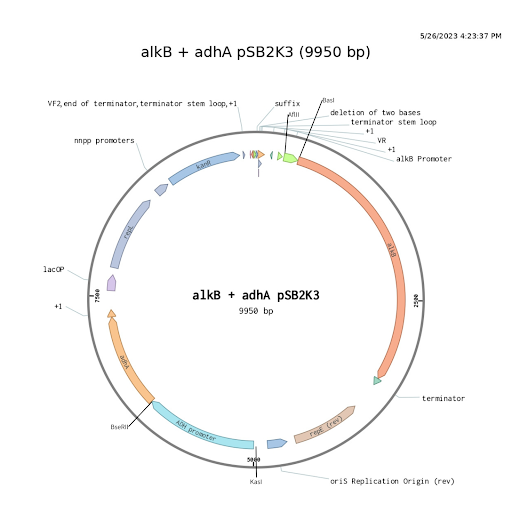Alex Hymson, Ian Kelley, Eli Landsman, Trevor Wilson, Gabe Wolter ▫ BioBuilderClub, Oak Park and River Forest High School, Oak Park, Illinois, United States
Reviewed on 6 May 2023; Accepted on 13 July 2023; Published on 16 October 2023
With help from the 2023 BioTreks Production Team.
Our study aims to find an effective, eco-friendly, and commercially viable solution to diminish the negative effects of a crude oil spillage on aquatic ecosystems. It’s important that we address the effects of crude oil on aquatic life because when exposed to oil, adult fish may experience reduced growth, enlarged livers, changes in heart and respiration rates, fin erosion, and reproduction impairment. To solve this, an Escherichia coli strain engineered to express alcohol dehydrogenase (adhA) and alkane hydroxylase (alkB) was designed. As a result, the design of our plasmids includes two separate DNA sequences. We anticipate that there will be increased efficiency in plasmid function as a result of using both sequences. Both proteins, adhA and alkB, will be expressed at a low transcription rate as long as energy and food requirements for the bacteria are met. The alkB gene breaks down alkanes, saturated hydrocarbons, by oxidizing the hydrocarbon into alkanols (in the case of aliphatic hydrocarbons) or phenols (in the case of aromatic molecules) and to be metabolized in further metabolic steps. The adhA gene degrades oil into fatty alcohols that can be repurposed, providing an economic incentive and benefit for oil companies to not only use our product, but work harder to clean up their oil spills.
Keywords: Alkane hydroxylase (alkB), Alcohol dehydrogenase (adhA), oil degradation, crude oil, Isopropyl β-D-1-thiogalactopyranoside (IPTG)
Authors are listed in alphabetical order. Matthew Kirkpatrick and Benjamin French from BioBuilderClub, Oak Park and River Forest High School, Oak Park, Illinois, United States. mentored the group. Please direct all correspondence to .
Crude oil spillage has significant negative impacts on aquatic ecosystems. Oil spills, the most visible impact, spread and contaminate vast areas by releasing toxic compounds like polycyclic aromatic hydrocarbons (PAHs) and heavy metals. These toxins harm marine life, disrupt food chains, and lead to physical coating and smothering of organisms. The spills also contaminate water and sediments, causing long-term toxicity. Furthermore, oil spills deplete oxygen, affect reproduction and development, and have lasting effects on ecosystems. Preventing spills, improving safety measures, and transitioning to cleaner energy sources are crucial for mitigating these impacts and safeguarding aquatic ecosystems. As long as oil fracking is prevalent, it will negatively impact aquatic ecosystems. To combat this ecosystem destruction, we created a precautionary measure to lessen the effects of aquatic oil spills on nearby aquatic ecosystems. We designed plasmids that code for the expression of proteins that will organically breakdown the hydrocarbons in crude oil to smaller, less invasive molecules. Our experiment includes inserting plasmids into the same crude oil solution in 5 different beakers (see Figure 1). In beaker one, there is no inserted plasmid, so it acts as a negative control.

| Figure 1: 5 beaker hypothetical experiment |
In beaker two (labeled sample 1 in Figure 1), our alkB solo plasmid (see Figure 2) after being transformed into the E. coli DB3.1 strain through heat shock should be inserted. In beaker three, the E. coli strain DB3.1 plus the inserted adhA solo plasmid (see Figure 3) will be added.

| Figure 2: Benchling alkB solo plasmid that will be inserted into sample 1. |

| Figure 3: Benchling adhA solo plasmid that will be inserted into sample 2. |
In beaker four, our combined alkB and adhA plasmid (see Figure 4) that was transformed into E. coli strain DB3.1 was inserted. Finally, in beaker five both the alkB solo plasmid transformed in E. coli and adhA solo plasmid transformed in E. coli were inserted (see Figure 5).

| Figure 4: Benchling alkB + adhA combined plasmid that will be inserted into sample 3. |

| Figure 5: The respective treatment in sample 4 includes both the Benchling alkB solo and Benchling adhA solo plasmid added to the beaker collectively. |
Systems level
In terms of the complete biological system, the three designed plasmids are all separate biological systems. In terms of each plasmid, they all achieve our team’s goal of naturally breaking down crude oil into smaller subunits that make further breakdown of crude oil components by preexisting organisms in the aquatic ecosystem easier. Our organisms function in the environmental system, creating a healthier environment for other organisms in the aquatic ecosystem.
Device level
Our plasmid will be inserted into E. coli DB3.1. E. coli is commonly used in genetic modification because it is easy to grow and manipulate. Additionally, its genetic structure is well understood. As a prokaryote, E. coli is a simpler organism. This simplicity allows for a more efficient plasmid transformation through heat shock.
We engineered the plasmid pSB2K3 to contain genes encoding the alkB and adhA proteins. We introduced alkB into the plasmid via the BasI cut site, PalkB into the KasI cut site, adhA in the KasI cut site and the ptac promoter into the BpmI cut site. The above components put our combined plasmid (Figure 4) at 16,704 base pairs. In an effort to decrease the plasmid size, we designed two separate pSB2K3-derived plasmids, one with alkB and the other with adhA. We added the genes and promoters to the same cut sites as above. Their respective plasmid sizes were 7,596 base pairs for the alkB solo plasmid and 13,533 base pairs for the adhA solo plasmid. In order for each plasmid to function, the addition of an inducer is necessary. For every plasmid the IPTG inducer should be added to intensify the activation of the transcription factors. In addition, alkS should be added to any of the plasmids including the alkB gene to activate the PalkB promoter. For the adhA gene, the ptac promoter is also activated by the IPTG inducer.
Parts level
Each of our proteins play their own important role in oil degradation. They both work to break down the components of crude oil.
AdhA (Part:K398014) functions to breakdown hydrocarbons has an economic benefit because the products of this breakdown can be repurposed. AdhA comes from Lactococcus lactis (Registry). This makes our project desirable to petroleum companies that can soak up some of their lost money in the event of an oil spill. AdhA breaks down fatty-acid chains into fatty-alcohol effectively.
Ptac (Part:BBa K180000) is the promoter we used to activate the transcription of the adhA gene from iGEM (Registry). Ptac is characterized as a functional hybrid promoter that is derived from the trp and lac promoters. Ptac is activated by the IPTG inducer. Lastly, ptac is useful compared to its single-parent promoters trp pR and lac pR, as it has a stronger binding affinity than either of its parent promoters (Registry).
Alkane hydroxylase (alkB) appeared at the highest frequency in the studies we researched on the National Center for Biotechnology Information (PMC Journal List). We specifically chose an alkane hydroxylase (alkB) gene of the Gordonia sp. TF6 system (Part:BBa_K398014). AlkB adds one or two oxygen molecules to the hydrocarbon, so that it can be broken down into smaller ringed structures like which is then converted to an alkanol (aliphatic hydrocarbon) or a phenol (aromatic hydrocarbon) to expedite the crude oil break down process. And by breaking down the size of crude oil, the oil’s impact on aquatic environments decreases.
The promoter used for alkB is the PalkB inducible promoter (Part:BBa M36250. PalkB comes from Pseudomonas putida and is found upstream of the alkB gene in its native setting. PalkB is activated by the transcription factor alkS (its description is in the same source as PalkB). It has been stated by the iGEM Registry that it is currently hypothesized that other external factors govern PalkB’s usability, as previous attempts to utilize this part in conjunction with AlkS in E. coli have been successful.
The inducer we used, IPTG (Isopropyl β-D-1-thiogalactopyranoside), is a molecular analog of allolactose which removes a repressor from the lac operon to induce gene expression. The addition of IPTG to the growth media activates the transcription for both genesby biding to the repressor that can no longer bind to the operator and the operon begins to be transcribed. When transformed E. coli is induced with IPTG, the P1 lytic replication proteins are produced and the P1 lytic replication origin takes over, raising the copy number to very high levels (greater than 100 copies per cell).
Safety
To ensure that our product is safely used to decontaminate polluted seawater, we will not deploy it into aquatic ecosystems. Direct application of our product into seawater will raise concern for the environment and community and would also prompt further investigation into the safety of our product. Instead, water will be collected using traditional oil cleanup methods, such as skimmers, and placed in distillery tanks where we will introduce our modified E. coli. The end product, seawater and fatty alcohol, will then be distilled. The useful product will be reclaimed, and the seawater will undergo a chlorine shock process to eliminate E. coli (see Step 7 for the process). Then the seawater will be returned to the ecosystem and the natural bacteria found in the seawater will further aid in oil degradation.
During initial testing in the laboratory, a less invasive and more readily available approach of using olive oil instead of crude oil can be adopted. This is possible because olive oil contains alkanes similar to crude oil, yet there are other components that make olive oil and crude oil chemically different. While olive oil is a less invasive oil, in order to attain the most valid results, crude oil should be used in further testing.
Discussions
Our experiment’s main challenge was limiting the size of our edited plasmids. Both of our proteins combined with the iGEM pSB2k3 plasmid backbone exceed a 5000 bp length. Specifically, our adhA gene alone is 9,028 bp while our alkB gene alone is 2,932 bp. This plasmid size is not ideal for plasmid transformation as the efficiency of the transformation drops when plasmid size increases.
On the other hand, our project benefits from using two proteins simultaneously to degrade the crude oil in the environment. This allows for us to target a larger spectrum of oils to break down while also allowing us to break down our crude oil substrate into reclaimable products. If successful, our project could lead to massive breakthroughs in oil spill cleanup.
Next steps
For the next steps of our project, our team, a team from the Oak Park and River Forest Bio-Research club, or another team of scientists, can move forward with testing our plasmids in functioning E. coli. We believe we have done much of the hard work to make testing possible in the future, we just ran out of time as we are all seniors in high school. In addition, salinity testing is a major step we need to take in the future. Understanding the ecosystem and environment we will be applying our project to have a major impact on the functionality and effectiveness.
Hypothetical experiment
We hope that another group of scientists could use our plasmid designs to run the aforementioned experiments.
Experiment materials:
- 5 500mL beakers
- The 3 plasmids: alkB solo, adhA solo, and the alkB + adhA combined
- 1,500mL of water
● Sample of 1.5mg crude oil.
● IPTG inducer
● 10 pH strips
Possible methods:
- Label beakers 1-5, where beaker 1 is also labeled “control”.
- In each of the 5- five 500mL beakers put 300mL of water and 0.3mg of crude oil, so you have an equal amount of seawater and crude oil in each beaker.
- Find the pH of the combined seawater and crude oil in each beaker and record the results.
- Then add each transformed bacteria group to their respective beaker (see Figure 1):
- In beaker 2 add the alkB solo plasmid (see Figure 2)
- In beaker 3 add the adhA solo plasmid (see Figure 3)
- In beaker 4 add the alkB + adhA combined plasmid (see Figure 4)
- In beaker 5 add both the alkB solo and adhA solo plasmid (see Figure 5)
5. Add the IPTG inducer to beakers 2-5 at the same time. Then add the alkS inducer to beakers 2, 3, and 4.
6. Let the beakers incubate at 29 degrees Celsius for 20 minutes.
7. Record the pH of beakers 1-5 and take notice of any pH changes.
We would want to figure out a way to have an inducible backbone that would become induced by the contents of crude oil, e.g., alkanes.
Author contributions
The two major contributors to this paper were T.W. and G.W., with minor help from E.L., I.K. and A.H. The related research was an entire team effort with all members contributing to the team’s success with TW, GW, and EL leading the team in direction.
Acknowledgements
The team was heavily influenced and helped by Matthew Kirkpatrick, the organizer and teacher of the OPRF Bio-Research club, along with Benjamin French, a graduate student at the University of Toledo in Ohio.
A big thank you to the OPRF science department for organization and funding.
References
Adlan, N. A., Sabri, S., Masomian, M., Ali, M. S. M., & Rahman, R. N. Z. R. A. (2020). Microbial biodegradation of paraffin wax in Malaysian crude oil mediated by degradative enzymes. Frontiers in Microbiology, 11, 565608. https://doi.org/10.3389/fmicb.2020.565608
Benchling. (n.d.). Discover the power of Benchling. https://www.benchling.com/
Dinamarca, M. A., Aranda-Olmedo, I., Puyet, A., & Rojo, F. (2003). Expression of the Pseudomonas putida OCT plasmid alkane degradation pathway is modulated by two different global control signals: Evidence from continuous cultures. Journal of Bacteriology, 185(16), 4772-4778. https://doi.org/10.1128/jb.185.16.4772-4778.2003
iGEM. (2014, October 6). Part:BBa K1465301. http://parts.igem.org/Part:BBa_K1465301
Kosuri, S. (2004, May 4). Part:pSB2K3:Inducible copy number BioBrick plasmid. iGem. https://parts.igem.org/Part:pSB2K3
Luo, Q., He, Y., Hou, D. Y., Zhang, J. G., & Shen, X. R. (2015). GPo1 alkB gene expression for improvement of the degradation of diesel oil by a bacterial consortium. Brazilian Journal of Microbiology, 46(3), 649-657. https://doi.org/10.1590/S1517-838246320120226
Masutani, E. & Erica Lieberman, E. (2011, December 9). Part:BBa M36250. iGEM. http://parts.igem.org/Part:BBa_M36250
NOAA. (2023, August 24). How does oil impact marine life?. https://oceanservice.noaa.gov/facts/oilimpacts.html
Ontario. (2022, June 6). What to do if your well is contaminated with bacteria. https://www.ontario.ca/page/what-do-if-your-well-contaminated-bacteria
Schipper, K. & Voges, M. (2010, October 7). Part:BBa K398014. iGEM. http://parts.igem.org/Part:BBa_K398014
Smith, C. B., Tolar, B. B., Hollibaugh, J. T., & King, G. M. (2013). Alkane hydroxylase gene (alkB) phylotype composition and diversity in northern Gulf of Mexico bacterioplankton. Frontiers in Microbiology, 4, 370. https://doi.org/10.3389/fmicb.2013.00370
Sui, Y. A., Kishino, S., Maruyama, S., Ito, M., Muramatsu, M., Obata, S., & Ogawa, J. (2022). Utilizing alcohol for alkane biosynthesis by introducing a fatty alcohol dehydrogenase. Applied and Environmental Microbiology, 88(23), e01264-22. https://doi.org/10.1128/aem.01264-22 Wilson, R. & Chambers, S. (2009, October 12). Part:BBa K180000. iGEM. http://parts.igem.org/Part:BBa_K180000

